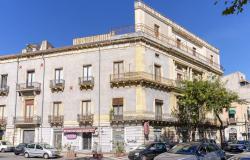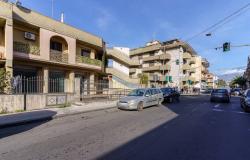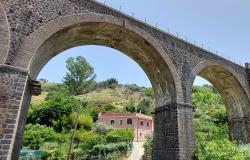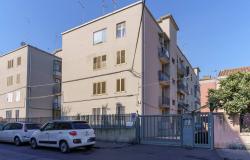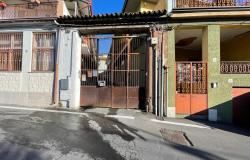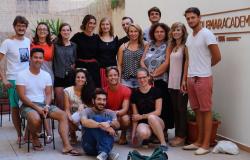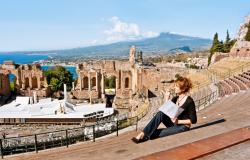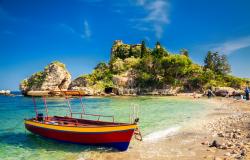Sicily is Italy's largest region and the largest island in the Mediterranean Sea. Separated from Calabria by the Strait of Messina, it includes the islands of Pantelleria and Ustica as well as the Aeolian, Egadi and Pelagian Islands.
The territory is mainly hilly and mountainous with Etna, the highest active volcano in Europe, dominating the Plain of Catania to the east and a series of peaks along the north western coast. The three main coastal plains are traversed by the Simeto, Alcantara, Salso, Belice, Torto and Platani rivers. Agriculture is very active, with large inland cereal cultivations and some highly specialised coastal crops (citrus fruits, grapes, olives, almonds and hazelnuts). Just as important for the region's economy are fishing and tourism. Shipbuilding is concentrated in Palermo and Messina, while hydrocarbon production and refining has favoured the installation of large petrochemical structures (Augusta, Ragusa, Gela, Milazzo and Porto Empedocle) alongside plants that process potassium salts. In addition to the traditional sectors, the island's economy has seen the development of activities associated with new technologies, especially computers and telecommunications in the province of Catania, in the so-called "Etna valley". Two important technological poles are the Department of Chemical Processes and Material Engineering at the University of Palermo and the National Research Council's Institute for Microelectronics and Microsystems in Catania.
Among the countless festivals connected to the rites and celebrations of patron saints, the most spectacular are the ones for Santa Rosalia in Palermo and Sant'Agata in Catania. Ever since the Spanish era, during the Holy Week before Easter, the Mysteries processions have been held in Trapani, Caltanissetta, Modica and many other smaller towns and villages. For beautiful landscapes there is the Zingaro Nature Reserve (in the Province of Trapani), and the area of Monte Cofano with the ancient troglodytic caves in Scurati. Between Trapani and Marsala, in the protected area of Stagnone, is the Via del Sale with windmills for processing salt, some of which are still operating, while others are set up as historical and anthropological museums. An obligatory stop-off is the island of Mozia with the Withaker Archaeological Museum.
On the eastern side of the island not to be missed is the Baroque art, today under the protection of UNESCO, of Ragusa, Ibla, Noto and Modica. Of extraordinary naturalist interest is the park of Etna, the largest active volcano in Europe. Popular art finds its expression in the puppet theatres of the historic centres of Palermo and Catania. The queen of Sicilian sweets is the "cassata", with its rich ricotta and candied fruit, an ancient delicacy of Arabic origin. Finely shaped and coloured marzipan fruits are also a treat for the eyes.
The culture of fine dining may have been conceived in Sicily when Archestratus, a Greek poet born at Gela in the 4th century B.C., wrote Gastronomia as an ode to the pleasures of the Sicilian table. Outsiders before and since have sung the praises of the bountiful seas and fertile volcanic soils of this island crossroads of the Mediterranean.
The Greeks, among their other contributions to Sicilian cooking, introduced whole grain and refined flours for flatbreads that were forerunners to focaccia. They planted the Malvasia and Moscato vines that are still prominent today. They also seem to have used the snows of Mount Etna to make ices based on fruits and honey.
The strongest outside influences on Sicily came from Saracens and other Arabs in the Middle Ages. They brought spices from the east and introduced cane sugar for the making of sorbets, pastries and cakes, including the elaborate cassata that heralded Sicily's reputation as a treasure island of sweets. Arabs founded a pasta industry near Palermo in the 12th century, using grain from fields planted earlier by the Romans. They introduced methods of fishing tuna and swordfish in deep Tyrrhenian waters. Curiously, though, what Sicilians call cùscusu is made with fish, where in North Africa couscous generally contains lamb.
Sicily is Italy's second most prominent producer of organic foods after Sardinia. The island's year-round supply of fresh vegetables and herbs triumphs in salads, both raw and cooked. Tomatoes are omnipresent, though equally adored are eggplants (which may be fried, baked with cheeses or stewed and served cold as caponata) and peppers (which may be grilled, stuffed, baked, or stewed in peperonata).
Sicilian olive oil is also prized, as are the DOP table olives called Nocellara del Belice. The outlying islands specialize in capers, best known as the IGP Capperi di Pantelleria, though the Lipari or Aeolian isles are also noted for these tasty flower buds preserved in sea salt.
Seafood, led by sardines and anchovies that figure in many recipes, is eaten throughout the region. Along the coasts, the features are fresh tuna and swordfish, which may be marinated in oil and herbs, stewed or roasted or cut into steaks and grilled.
Cheeses are dominated by Pecorino Siciliano DOP, also known as tuma or tumazzu, whose pungent flavor is sharpened when laced with peppercorns. When aged and hard, Pecorino is used for grating. Ragusano DOP is a cow's milk cheese, mellow and delicate when young, though it may also be aged hard and sharp for grating. Caciocavallo and provola or provoletta are also popular. Creamy soft ricotta is used in pasta fillings and pastries, though it may also be salted and dried.
The region is a major producer of fruit, notably oranges and lemons, peaches, apricots, figs and table grapes, which rate an IGP from Canicattì. The region is famous for blood oranges, IGP as Arancia Rossa di Sicilia. A delicious curiosity is the prickly pear called Fico d'India which grows on cactus.
Sicily has Italy's greatest expanse of vineyards and often produces a greater volume of wine than any other region. The most renowned of its 17 DOCs is Marsala, the quintessential cooking wine, though in its toasty vergine or solera versions it makes an excellent aperitif and match for ripe cheeses. Sicily is noted for sweet wines, such as Moscato Passito di Pantelleria and Malvasia delle Lipari, but its growing reputation is for dry table wines: reds such as the full bodied Nero d'Avola and fresh, fruity whites, which go so well with seafood and vegetables.
